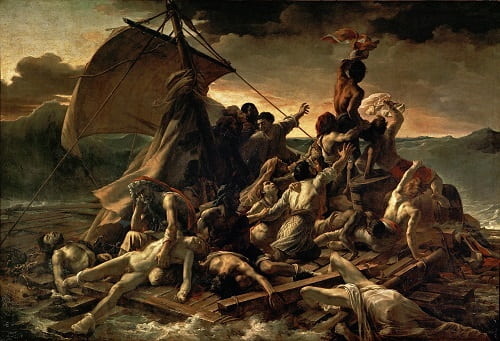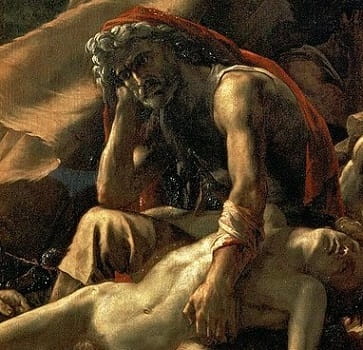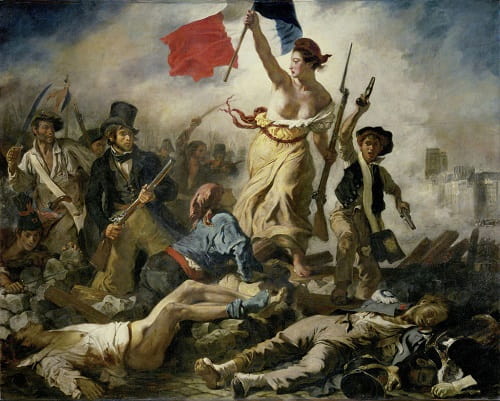The Raft of the Medusa Analysis
In the vast world of art history, few paintings elicit as much emotion and fascination as “The Raft of the Medusa.” This iconic masterpiece, created by French Romantic artist Théodore Géricault, stands as a powerful symbol of human suffering and resilience. In this analysis, we delve into the historical background, artistic elements, and profound message behind this monumental work of art.
The Raft of the Medusa Analysis: A Masterpiece of Romanticism and Tragedy
Historical Background of The Raft of the Medusa Painting
“The Raft of the Medusa” is a monumental painting by Théodore Géricault, created between 1818 and 1819. The work is an iconic representation of a tragic historical event that captured the public’s imagination and had a significant impact on French society during the early 19th century.

The Raft of the Medusa, 1818-1819 by Théodore Géricault.
The Shipwreck of the Méduse
The painting is based on the shipwreck of the French frigate Méduse, which occurred in July 1816 off the coast of Mauritania (modern-day Senegal). The Méduse was carrying French officials and colonists who were being sent to reclaim the colony of Senegal from the British. The ship was poorly constructed and sailed with inexperienced crew members.
The Abandonment and Raft Construction
Due to poor navigation and leadership, the Méduse ran aground on a sandbank. As the ship began to sink, the lifeboats were insufficient to carry all the passengers. A makeshift raft was constructed to accommodate around 150 people, but it was hastily built and poorly designed. The captain and officers quickly abandoned the raft, leaving the passengers and crew to fend for themselves.
Ordeal on the Raft
The people on the raft faced unimaginable hardships. With limited supplies, they endured exposure to the scorching sun, dehydration, and starvation. The lack of proper leadership and organization led to chaos, and desperation set in as the survivors resorted to cannibalism to stay alive. Only 15 out of the approximately 150 people on the raft survived the ordeal when they were finally rescued after 13 days adrift at sea.
Public Outrage and Political Fallout
News of the tragedy and the subsequent scandal surrounding the ineptitude of the captain and officers spread rapidly. The incident became a symbol of government corruption, incompetence, and disregard for human life. The public was outraged, and the political fallout was significant, leading to a series of trials and investigations.
Géricault’s Motivation
Théodore Géricault, a young French artist with a keen interest in human emotion and the sublime, was deeply moved by the tragic events of the Méduse shipwreck. He saw it as an opportunity to create a work that not only captured a significant historical event but also spoke to the broader themes of human suffering and resilience.
The Painting
Géricault conducted extensive research for the painting, interviewing survivors, studying cadavers, and even creating a life-size model of the raft to ensure accuracy. The final composition depicts the survivors in a moment of despair, hope, and desperation, with some waving for rescue and others succumbing to exhaustion.
“The Raft of the Medusa” is not just a powerful work of art but a testament to the tragic historical event that shook French society. Théodore Géricault‘s portrayal of the survivors’ plight serves as a poignant reminder of the consequences of human arrogance and the strength of the human spirit in the face of adversity. The painting remains a lasting tribute to the resilience of those who endured the harrowing ordeal on the raft and a timeless exploration of the human condition.
Recommended For You – 10 Famous Realist Artists of All Time
Symbolism and Emotions in “The Raft of the Medusa” Painting
“The Raft of the Medusa” by Théodore Géricault is not only a powerful depiction of a tragic historical event but also a work of art rich in symbolism and emotional depth. Through the use of various artistic elements, Géricault effectively conveys the harrowing experiences and emotions of the survivors, while also imbuing the painting with broader symbolic meanings.
1- Despair and Hope
The painting captures the intense emotions of despair and hope among the survivors. Some figures are shown with anguished expressions and gestures of desperation, while others raise their arms and wave pieces of cloth in a desperate attempt to signal for help.

Figure Details of The Raft of the Medusa, 1818-1819 by Théodore Géricault – The Raft of the Medusa Analysis.
These contrasting emotions add to the emotional intensity of the scene, evoking a sense of empathy and sympathy from the viewers.
2- Human Suffering
Théodore Géricault‘s meticulous attention to the physical condition of the survivors is a powerful representation of human suffering.

The emaciated bodies, exhausted faces, and contorted postures emphasize the immense hardship and agony endured during their ordeal at sea. – Figure Details of The Raft of the Medusa, 1818-1819 by Théodore Géricault – The Raft of the Medusa Analysis.
The emaciated bodies, exhausted faces, and contorted postures emphasize the immense hardship and agony endured during their ordeal at sea. This portrayal serves as a reminder of the fragility of human life and the brutal consequences of the shipwreck.
3- A Thoughtful Man in the Shipwreck of the Méduse
In “The Raft of the Medusa” painting, the bearded and thinking man with his hand on his head is often identified as Alexandre Corréard, one of the shipwreck survivors.
Alexandre Corréard was a hydrographer and engineer who was aboard the ill-fated French frigate Méduse when it sank off the coast of Mauritania in 1816.

Alexandre Corréard – Alexandre Corréard (8 October 1788 – 16 February 1857) was a French engineer and geographer. He graduated from the engineering school Arts et Métiers ParisTech – The Raft of the Medusa Analysis.
Géricault’s decision to depict Corréard in such a contemplative and introspective pose adds depth to the painting’s emotional impact. The man’s expression of deep thought and despair reflects the psychological toll of the harrowing experience endured by the survivors on the raft.
Corréard later co-authored a book titled “Narrative of a Voyage to Senegal in 1816” (published in French as “Naufrage de la frégate la Méduse”) with another survivor, Henri Savigny. The book detailed the tragic events of the shipwreck and the survivors’ ordeal on the raft, providing a firsthand account of the disaster. Géricault’s painting helped to bring attention to the survivors’ story and the incompetence of the ship’s crew and officers, leading to increased public awareness and outrage.
The inclusion of Alexandre Corréard in “The Raft of the Medusa” serves as a representation of the individual experiences and the profound impact of the tragedy on those who lived through it. His presence, like that of the other survivors, adds a personal and human dimension to the painting, making it a powerful portrayal of the human condition in the face of adversity.
4- The Flag
At the top of the makeshift mast, a single figure waves a flag in a desperate plea for rescue.

The Flag – The Raft of the Medusa Analysis.
The flag, a symbol of national identity and hope, became a beacon of survival in the vastness of the open sea. It also highlights the survivors’ faith in the possibility of rescue, despite their dire circumstances.
5- The Pyramid Composition
Géricault‘s deliberate use of a pyramid composition guides the viewer’s eye toward the apex of the painting. At the top, the figure waving the flag stands as the central focal point, drawing attention to the survivor’s determination and resilience.

A pyramid composition in The Raft of Medusa – The Raft of the Medusa Analysis.
This composition adds a sense of stability and balance to the chaotic scene while emphasizing the importance of this lone figure’s actions.
6- The Stormy Sea
The tumultuous sea in the background of the painting symbolizes the uncontrollable forces of nature. It represents the overwhelming power of the ocean that the survivors must confront and endure.
The stormy sea also reinforces the perilous situation faced by the survivors and intensifies the sense of danger and isolation.
7- Romanticism in The Raft of the Medusa
“The Raft of the Medusa” is a quintessential example of the Romantic movement in art, which emphasized the sublime and awe-inspiring aspects of nature.
The vastness of the ocean, the dramatic lighting, and the grand scale of the painting evoke feelings of awe and wonder. Géricault‘s portrayal of the survivors’ struggle against the forces of nature embodies the Romantic notion of the individual’s confrontation with the sublime.
Recommended For You – Francisco Goya’s The Third of May 1808 Analysis
“The Raft of the Medusa” is a masterful composition that goes beyond depicting a historical event. Théodore Géricault’s use of symbolism and emotions serves to amplify the human experience of suffering, hope, and resilience.
The painting’s enduring impact lies in its ability to evoke deep emotional responses from viewers while reflecting broader themes of the human condition and the power of nature.
Influence of “The Raft of the Medusa”
1- Contemporary Reception
When “The Raft of the Medusa” was exhibited at the Paris Salon in 1819, it caused a sensation among viewers and critics. The painting’s dramatic portrayal of the shipwreck and the survivors’ plight elicited strong emotional reactions and garnered widespread attention.
Géricault’s masterful execution and attention to detail were praised, and the painting was hailed as a groundbreaking work of Romanticism.
2- Artistic Influence
Géricault’s painting had a profound influence on subsequent generations of artists. Many artists were inspired by his skillful portrayal of human suffering and emotion.
Notably, Eugène Delacroix, another prominent Romantic painter, acknowledged the impact of “The Raft of the Medusa” on his own work.

Liberty Leading the People, 1830 by Eugène Delacroix.
The painting’s emphasis on emotion, individualism, and the sublime aligned with the ideals of Romanticism, and it helped solidify the movement’s influence in the art world.
3- Influence on Realism
While Théodore Géricault was a leading figure in the Romantic movement, his attention to realism in “The Raft of the Medusa” paved the way for the emergence of the Realist movement in the mid-19th century.
Realist artists sought to depict everyday life, social issues, and the hardships faced by ordinary people, much like Géricault did with the survivors on the raft. The painting’s focus on the harsh realities of human existence resonated with Realist artists, influencing their approach to representing contemporary life.
4- Art Education and Techniques
“The Raft of the Medusa” became an essential teaching tool in art academies and institutions.
Géricault’s innovative use of composition, lighting, and emotion served as a model for aspiring artists, and the painting was studied as an exemplary work of art. Many artists, both in France and abroad, looked to Géricault’s techniques and subject matter for inspiration in their artistic endeavors.
“The Raft of the Medusa” had a profound and lasting impact on the art world, influencing subsequent generations of artists and contributing to the development of Romanticism and Realism. Beyond its artistic significance, the painting’s social and political implications highlighted the potential of art as a powerful tool for commentary and change.
Today, it remains a celebrated masterpiece and a testament to the enduring power of art to reflect and shape the world in which it is created.
Where is ‘The Raft of The Medusa’ Located?
The Louvre Museum (Paris) acquired it soon after the artist’s death at the age of 32. The painting’s influence can be seen in the works of Eugène Delacroix, J. M. W. Turner, Gustave Courbet, and Édouard Manet.
Recommended For You – The 10 Best Art Museums in the World
References:
- https://en.wikipedia.org/wiki/The_Raft_of_the_Medusa
- https://fr.wikipedia.org/wiki/Alexandre_Corr%C3%A9ard








